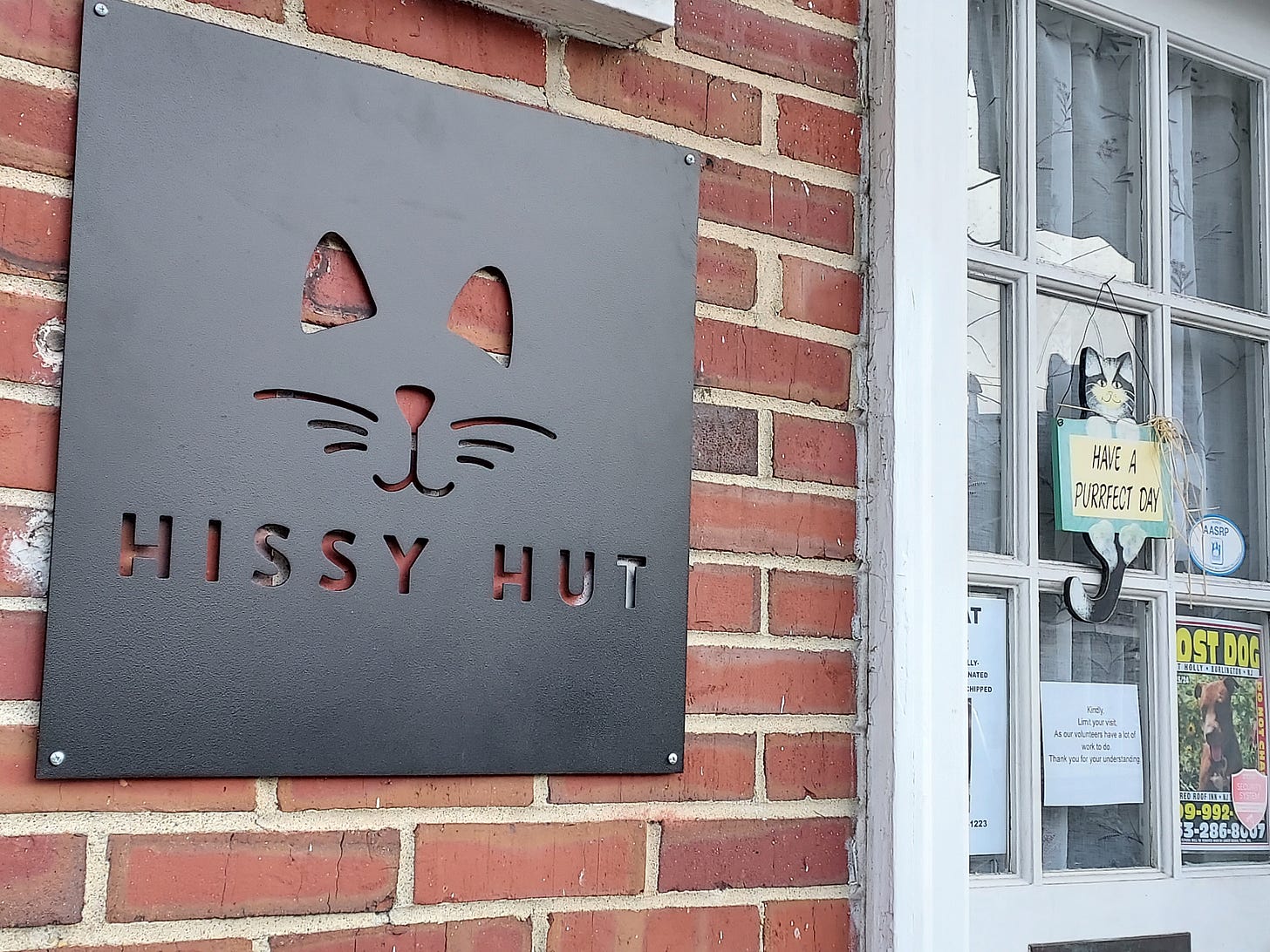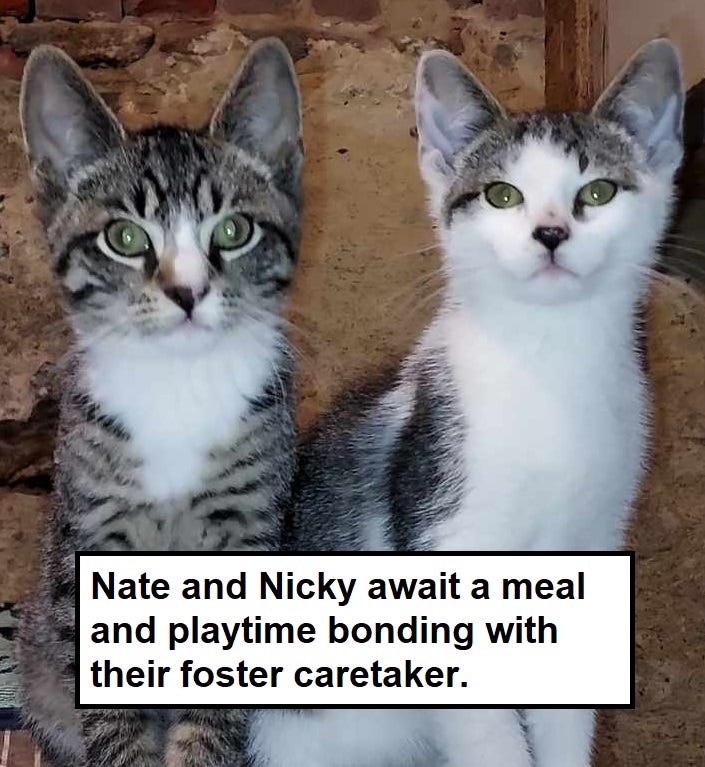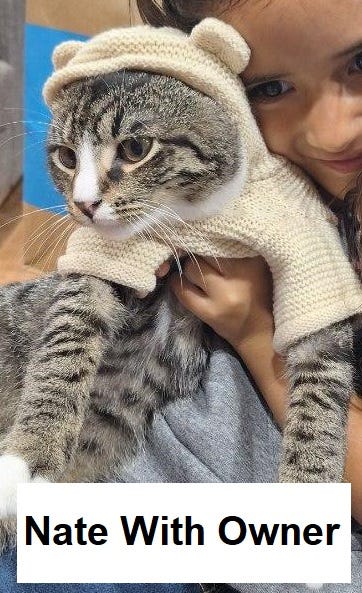WHATS THE HISSY HUT?
Non-profit Delivers Lower Cost, Humane Control Of Community Cats.
SUMMARY: The Friends Of The Burlington County Animal Shelter [FOBCAS] is a non-profit that helps care for county animal shelter pets and place them into adoptive homes. FOBCAS now owns the former veterinary building on Mill Street [Renamed the “Hissy Hut”] and runs it as an adoption center and as a medical recovery facility for Trap-Neuter-Release [TNR] cats that are returned to colonies in their townships of origin. A portion of TNR cats are found to be “friendlies” that can be offered for adoption at the Hissy Hut.
Cats that roam freely in our communities produce wildly divergent and emotional points of view amongst neighbors. Some see them as pests causing damage to property and wildlife populations. Others see them as suffering abandoned pets in need of care. Both points of view have some validity.
Traditional Population Management
Cats are extremely fertile creatures. Given enough food, adequate shelter and a little luck, the average female cat can deliver about 16 kittens per year. With some additional survival luck, each of those kittens can reach breeding age within 6 months.
In 2017, Camden County estimated that 24,600 cats were loose on county streets. Which means that, on average, each of the county’s 36 towns had nearly 700 feral/stray cats on the street.
Traditionally governments have tried to manage these populations with the dual strategies of adoption and eradication. The Burlington County Shelter goal is 100% adoption and in 2023, it achieved an 80% “live release” rate.
As you may have guessed, there are significant numbers of cats that come into the Shelter which are “not adoptable” and must be euthanized. In this way the shelter avoids reaching “capacity” which would preclude them from being able to intake adoptable animals.
Townships coordinate with the Shelter in animal control by managing the capture and transfer of animals to the shelter. Most towns do this by maintaining a contract with a private vendor that handles trapping. Mount Holly contracts with New Jersey Animal Control, LLC which is based in Medford. You may have seen their trucks around with the “NJAC” logo.
In towns that solely use trap and remove as the path to feral cat management, county stats show that the largest number of captured is less than 100 per year. As indicated by Camden County statistics, this is probably about 10% of feral and stray cat population on the street in any given town.
As shelters receive cats to be euthanized, breeding populations outpace trap and kill efforts. Newborn recruits eventually wander into the “vacuum” of any temporarily cleared area. These cats are looking for food and shelter to be provided by people who view them as suffering abandoned pets.
Paved With Good Intentions
Its estimated that 14% of residents will feed street cats. While the kindness of providing a full belly does reduce suffering for these community cats, ultimately it causes more suffering as cat populations increase. Sadly, about 75% of street kittens don't reach their sixth month. And those that do achieve maturity only live an average of 3.5 brutal years. Mortality is due to fighting and subsequent wound infections, diseases, starvation, exposure and vehicle strikes.
Enforcement Options
Some residents suggest that the township should aggressively enforce against residents who feed feral cats. While that is a possible option, its also fair to ask whether enforcement is likely to achieve success. Generally, townships are attempting to frugally manage staffing to handle more core municipal enforcement programs, such as property maintenance code enforcement. Should a township Administrator divert staff from the mission-critical housing tasks to search for bowls of hidden cat kibble?
And if discovery of illegal feeding is left to the occasional neighbor reporting neighbor, how effective would that be? Enforcement works theoretically, but in practice its not likely to eliminate cat feeding.
Mt Holly Embraces TNR & The Hissy Hut
In 2011, Mt. Holly acknowledged the losing nature of the eradication model by adopting ordinance 2011-09, which made Trap, Neuter and Release [TNR] legal in town. TNR leverages the good intentions of local feeders who previously undermined eradication efforts.
The ordinance always envisioned a non-profit rescue group as coordinating the TNR program as a kind of public/private partnership. In recent years that role has been filled by the Friends of the Burlington County Animal Shelter [FOBCAS].
In June of 2023, FOBCAS purchased the former veterinary clinic at 84 Mill Street which they renamed to The Hissy Hut.
The building now serves as TNR recuperation facility and cat adoption offices by appointment. Viewing hours of adoptable cats are planned for the public in the future. But for now, FOBCAS currently offers access to the Hissy Hut via occasional open house events and by scheduled visits for those interested in adoption. You can contact them at Hissyhut@friendsofbcas.org.
Note that adoptable cats are usually visible at the front window at the left side of the building. The Hissy Hut provides Mount Holly with its only pet-oriented experience in the downtown business district.
HOW TNR WORKS
The TNR ordinance leverages feline territorial behavior and resident feeding practices to establish non-breeding populations on a “home turf”. Cats are trapped from their original turf, neutered, vaccinated against rabies and the left ear is “tipped”. They are then returned to their “home turf” where the same “feeders” who formerly thwarted animal control efforts now maintain a non-breeding population.
TNR Success Stories: “Friendlies”
Friendlies are either feral individuals who are exceptionally well adjusted to people, or, are formerly owned cats that were dumped or strayed. A significant portion of the community cat population are friendlies.
Janet is a very shy but friendly wanderer that lived under a porch at 38 Garden Street. As you can see in the image below, her left ear was tipped when the FOBCAS TNR program captured her in 2022. She would have lived her life on Garden street, but I noticed a severe wobble in her walk. This turned her crossing of busy Garden Street for her evening meal into death defying act. It was just a matter of time before a car ended her life.
So I re-trapped Janet and sheltered her as a foster cat for some months until a friend adopted her. She received a thorough medical exam and her uncoordinated movement was diagnosed as Cerebral Hyperplasia. Its a brain development problem caused when kittens are born to a mother infected with the Panluekapinia virus.
Janet hit the TNR lottery. I noticed her adoptability and a friend gave her the forever home she deserves. She is now at ease in her comfortable bed and no longer has to wobble across dangerous Garden Street for her meals.
Three Kittens – FOBCAS received a request about three kittens born under a Risdon Street shed. The shed owner was unaware of the births, but a neighbor notified FOBCAS that playful kittens were visiting her yard for meals. The feral mother was TNR’ed and released back to the neighbor’s yard in June of 2023. The kittens were captured and fostered by me. When I relinquished ownership of the kittens to the Shelter, they conducted an intake exam and the medical staff provided three names based on the first letter of my name: Nicky, Nate and Nadine.
At first, the bewildered kittens were fearful of their new basement home. But as I kept delivering warm means and coaxing play, Nicky broke the ice by chasing a feather. Soon all 3 and were purring when I entered the room and scratched their ears.
A frightening sickness arrived and all three stopped eating. FOBCAS intervened again with payment guarantees to the Mt. Laurel Animal Hospital that I didn’t have to shoulder that cost. With the quick medical intervention, the kittens weathered that storm and were back on track toward adoption. They were given a clean bill of health by the County Shelter Veterinarian who vaccinated and microchipped each of them. I took their bittersweet “graduation photos” which were posted on the Shelter’s private partner website called “petango”. They each found enthusiastic adopters who gave them homes far from the brutal life that would have awaited them on Risdon Street. Some time after these kittens were adopted, the new owners sent me some photos of their new lives.
A Virtuous Cycle
But not all the “TNR-ed” cats are so lucky as to get that winning lottery ticket into a warm loving home. Some are feral and not well suited for living indoors. For these animals, the best option is to be placed back on the street where they become part of a colony of “community cats” who are fed by caretakers.
These TNR cats not only stop breeding, their neutered condition makes them less inclined to fight or display other aggressive behaviors. With food and shelter supplied by a caretaker, or multiple caretakers, a virtuous cycle is set up where the smaller, well fed population has no pressure to hunt birds and less inclination to damage private property. The shelter has less cats to euthanize and therefore shelter employees experience less trauma of having to kill healthy animals. And all with a greatly reduced expenditure of tax dollars since the capture, transport, neutering and feeding is privately funded and the need to euthanize is eliminated.
FOBCAS needs volunteers and contributions to keep up this good work.
https://friendsofbcas.org/support/donate/
https://friendsofbcas.org/support/volunteer/
If you notice feral cats in your area and want then to get the “TNR” treatment while you provide some food afterwards, email FOBCAS at friends.say.snip.it@friendsofbcas.org.
If you want to adopt, check the following link
https://friendsofbcas.org/adopt/how-to-adopt/










